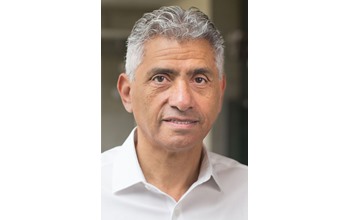Ahmed M. Abdel-Ghaffar, an internationally known University of Southern California civil engineering professor specializing in the analysis and monitoring long span flexible bridges,
died April 17, 2008, at the age of 61, after a long illness.
Abdel-Ghaffar’s 1974 investigation of the dynamic characteristics of the Vincent Thomas Bridge in Los Angeles, done when he was a graduate student, led to new standards on how to collect, analyze and interpret structural dynamic measurements from complex, three-dimensional, extended structures. His investigation allowed the development of high-fidelity computational tools used to reliably design such structures to resist the action of earthquake ground motion. The California Department of Transportation (Caltrans) used Abdel-Ghaffar’s computer program when it embarked on a major retrofit of the Vincent Thomas Bridge, and he served as a consultant, determining the damping characteristics of the bridge.
“Professor Abdel-Ghaffar’s excellence and innovation in the area of long span bridges was known internationally and he was much beloved by his students,” said Yannis C. Yortsos, dean of the USC Viterbi School of Engineering. “He is greatly missed by all of his colleagues here and around the world.”
"Building tall bridges that span engineering frontiers and withstand great earthquakes was Ahmed Abdel-Ghaffar's passion. Ahmed was a gentleman engineer and a dedicated educator," said Jean-Pierre Bardet, chair of the USC Sonny Astani Department of Civil and Environmental Engineering where Abdel-Ghaffar was on the faculty.
Abdel-Ghaffar also made major contributions to understanding and analyzing the behavior of structures interacting with soil during earthquakes. He was among the pioneers who conducted forced-vibration experiments on the Santa Felicia Earth Dam and interpreted its recorded seismic and dynamic response.
A meticulous writer with an eye for detail and eloquence, he was a gifted and dedicated teacher whose lecture notes continue to be used today by his students many of whom are professors at academic institutions worldwide.
A native of Egypt, Abdel-Ghaffar graduated in 1970 from Cairo University with a B.S. degree in civil engineering. He was the class valedictorian, earning a “first class honors” distinction. After working for two years as an instructor in structural engineering at Cairo University, he attended the California Institute of Technology, where he earned a master’s degree in civil engineering in 1973 and a Ph.D. with an emphasis on structural dynamics and earthquake engineering in 1976. His reputation at Cairo University as one of the most intelligent and attentive young lecturers led other aspiring Egyptian researchers to follow him to the United States.
Abdel-Ghaffar’s pioneering research at Caltech as a doctoral student under Prof. George Housner brought him international recognition in the then-emerging field of sensor-based monitoring of long span flexible bridges.
In 1978 Abdel-Ghaffar joined the Materials Engineering Department at the University of Illinois at Chicago-Circle and he moved to the Civil Engineering and Engineering Mechanics Department at Princeton University as an assistant professor the following year. He came to USC in 1987 as a full professor.
He served as a consultant to government agencies in the U.S., Japan, Europe, the Middle East, and elsewhere. Among Abdel-Ghaffar’s many notable projects, was one to monitor vibration of the Golden Gate Bridge and he hung a breathtaking photograph in his office showing him and his students standing near the top of the bridge while collecting sensor data.
During his long illness, he continued to interact from his bed with a number of international contacts and provide valuable advice on many projects, such as the long span bridge across the Gulf of Suez.
Abdel-Ghaffar, a resident of Rolling Hills Estate, was survived by his former wife and three children.
Prof. Dr. Eng. Ahmed El-Gamal;
Associate Dean for Faculty Affairs, School of Engineering, University of California, San Diego (UCSD)

Ahmed Elgamal is a Professor at the University of California, San Diego (UCSD). Currently, he is serving as the School of Engineering Associate Dean for Faculty Affairs. Earlier, he chaired the Department of Structural Engineering (2003-2007). He received his PhD in 1985 from Princeton University. In 1997, he joined UCSD after a Post-doctoral appointment at the California Institute of Technology (CalTech), and Faculty positions at RPI and Columbia University in New York.
His areas of research interest include liquefaction and effects on the built environment, large- scale soil-structure experimental and computational simulation, sustainability in Geomechanics, Information Technology (IT) applications, and system-identification procedures. He is author and co-author of over 250 Technical Publications, and currently serves as Editor-in- Chief of the Journal Soil Dynamics and Earthquake Engineering. Over the years, he has consulted and provided professional services in the general areas of Geomechanics and Geotechnical Engineering for a number of national and international organizations.
Recorded data sets from instrumented structures provide a wealth of information about the involved response mechanisms. Salient response characteristics extracted from analysis of such data sets will be presented and discussed. Valuable insights are derived for seismic site response, liquefaction and lateral spreading, Rockfill Dams, and Highway bridges and foundations, among other applications.